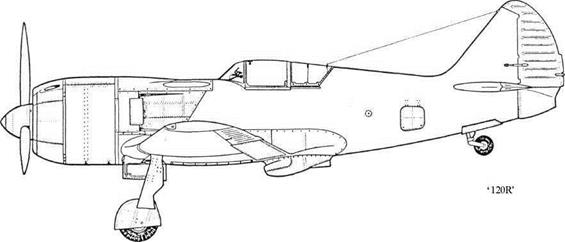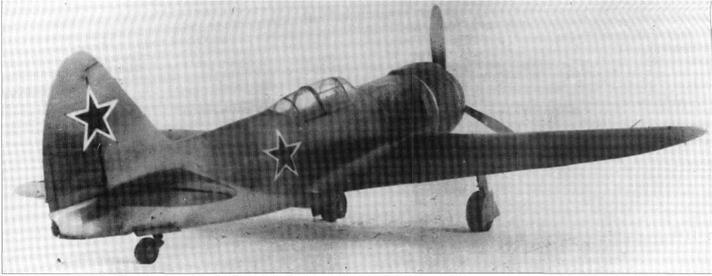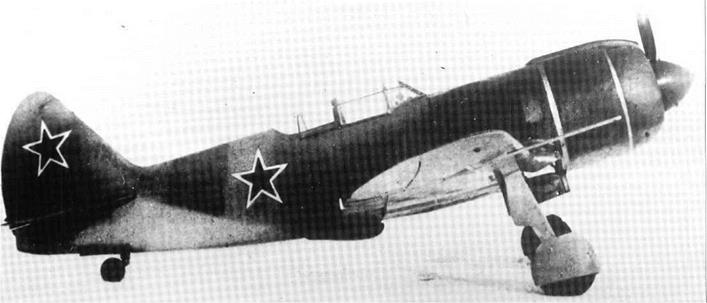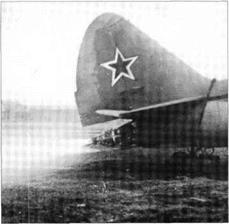Lavochkin La 7R and f120Rf
Purpose: To use a rocket engine to boost a fighter’s flight performance.
Design Bureau: OKB of Semyon A Lavochkin.
By early 1944 the all-wood La-5 fighter had given way in production to the La-7, with metal spars and other modifications. The engine remained the ASh-82FN 14-cylinder radial rated at 1,600hp. One ofthe first production aircraft was fitted with an RD-1 rocket engine in order to boost its performance, especially at extreme altitudes where the ASh-82 family of engines were less impressive. The installation was completed in the late autumn of 1944, and ground testing occupied nine weeks. In the last week of the year the assigned pilot, Georgii M Shiyanov, began the flight-test programme. Together with AVDavydov the La-7R was flown 15 times without serious malfunction, though the pro-
|
Above: Ground test of ‘120R’ rocket engine. Opposite: Two views of La-7R. |
gramme had to be abandoned because of progressive weakening of the rear fuselage by vapour and accidental spillage of the acid. Testing was continued with the RD-lKhZ installed in a second La-7R in early 1945. Brief testing was also carried out with a similar engine installed in the ‘120R’. On 18th August 1946 this aircraft excited spectators at the Aviation Day at Tushino by making a low flypast with the rocket in operation.
Both the La-7R test aircraft were originally standard production fighters. The RD-1 was one of the world’s first liquid-propellant rocket engines to fly in a manned aircraft, the designer being V P Glushko. The thrust chamber was mounted on a framework of welded steel tubes carried behind a modified rear fuselage frame, which merged at the top into the fin trailing edge. To accommodate the rocket the lower part of the rudder was removed. In the fuselage behind the cockpit were a stainless-steel tank for 180 litres (39.6 Imperial gallons) of RFNA (concentrated red fuming nitric acid) and 90 litres (19.8 Imperial gallons) of kerosene. These propellants were supplied by a turbopump energised by hot gas bled from the main thrust chamber. The turbine had a governed speed of 26,000rpm, and drove pumps for the two propellants plus lubricating oil and water supplied from a small tank to cool the turbine and thrust chamber walls. Mass of the installation was approximately 100kg (220 Ib), or 215kg (474 Ib) complete with propellants and water. The basic RD-1 had electrical ignition, while the RD-1KhZ had automatic chemical ignition from hypergolic liquids. The rocket was ofthe on/off type, cut in or out by a switch on the main throttle lever. It could not be varied in thrust (300kg, 661 Ib, at sea level), but could be shut off before the tanks were empty, nor
mal duration being 3 to 31/2min. Both La-7R aircraft retained their armament of two UB-20 cannon. The ’ 120R’ differed in having an ASh – 83 engine, rated at 1,900hp, armament of two NS-23 guns and in other details.
Together with such other aircraft as the Pe – 2RD and Yak-3RD these test-beds confirmed the value of a rocket engine in boosting performance at high altitude. On the other hand they also confirmed that RFNA is not compatible with a wooden structure, and in any case the value of three minutes of boost was considered questionable.
|
Dimensions (both) Span Length Wing area |
9.8m 8.6m 17.59m2 |
32 ft IK in 28 ft TM 189ft2 |
|
Weights (La-7R) |
||
|
Empty |
2,703kg. |
5,959 Ib |
|
Fuel and propellants |
604kg |
l,3321b |
|
Loaded |
3,500kg |
7,716 Ib |
|
Weights (‘120R’) |
||
|
Empty |
2,770kg |
6,107 Ib |
|
Fuel and propellants |
470kg |
l,0361b |
|
Loaded |
3,470kg |
7,650 Ib |
|
A standard La-7 typically had empty and loaded weights of 2,600kg and 3,260 kg |
Performance
(La-7R) generally unchanged, but maximum speed at 6 km (19,685 ft) altitude was increased from 680 km/h (422.5 mph) to 752 km/h (467 mph).
Service ceiling was increased from 10,700 m (35,105 ft) to 13,000 m (42,651 ft).
The only figure recorded for the ‘120R’ is a speed (height unstated) of 725 km/h (450.5 mph), but this speed (at 7,400 m) is also recorded for the unboosted ‘120’.














